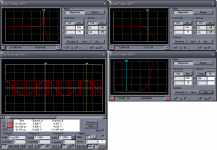I've been playing around with output filters and found out one rather ugly thing.
I've assemled an function generator outputting 200khz squarewave at 50% duty cycle, followed by LC filter with with cutoff @ ~7kHz (100uH, 0.47uF), connected to 4 ohm resistor.
With resistor in place everything is OK, but then I've assembled a dummy load (from ESP site) with loudspeaker impedance (you can see the impedance plot on lower right, I've tricked Bode plotter to measure impedance by using voltage controlled current source on input 😀 ), things got real ugly, you can see system responce with dummy load at upper left image and the trace on lower left, with output being a full blown sine wave at the frequency of that resonance instead of flat line with small ripple.
The question is, how ugly this gets in reality ? It is obvious that on higher frequency load impedance rises and filter gets unloaded. Sure, you can compensate some of this with feedback but opamps tend to run out of gain at higher f... sure, for sub it OK, nor it will be reproduced, nor it will bother anyone, but having alot of ultrasonic noise in wire is kinda wrong.
I've assemled an function generator outputting 200khz squarewave at 50% duty cycle, followed by LC filter with with cutoff @ ~7kHz (100uH, 0.47uF), connected to 4 ohm resistor.
With resistor in place everything is OK, but then I've assembled a dummy load (from ESP site) with loudspeaker impedance (you can see the impedance plot on lower right, I've tricked Bode plotter to measure impedance by using voltage controlled current source on input 😀 ), things got real ugly, you can see system responce with dummy load at upper left image and the trace on lower left, with output being a full blown sine wave at the frequency of that resonance instead of flat line with small ripple.
The question is, how ugly this gets in reality ? It is obvious that on higher frequency load impedance rises and filter gets unloaded. Sure, you can compensate some of this with feedback but opamps tend to run out of gain at higher f... sure, for sub it OK, nor it will be reproduced, nor it will bother anyone, but having alot of ultrasonic noise in wire is kinda wrong.
Attachments
What, no replies ?
So far I've discussed it with couple of people and we think maybe an impedance compensation will make things right.
So far I've discussed it with couple of people and we think maybe an impedance compensation will make things right.
Put a series cap and resistor in parallel with the load and tweak the values to help reduce the resonant peaking.
Part of the reason why post-filter feedback makes the UCD such a sucess.
Also would you mind describing your plots...its hard to interpret them.
Put a series cap and resistor in parallel with the load and tweak the values to help reduce the resonant peaking.
Some people call this a Zobel Network, and this is quite often used in linear amps as they tend to have a limited gain-banwidth product.compensate some of this with feedback but opamps tend to run out of gain at higher f
Also would you mind describing your plots...its hard to interpret them.
Gorilla said:Some people call this a Zobel Network, and this is quite often used in linear amps as they tend to have a limited gain-banwidth product.
Technically it isn't a Zobel network as implemented on the output of a class d amp. The purpose of a Zobel network is to level out the rising impedance of an inductive load. The purpose of the series resistor and cap on the class d output is to tame that resonant peak.
Which is caused by the rising impedance of a speakers inductive load?The purpose of the series resistor and cap on the class d output is to tame that resonant peak.
I do know where you are coming from tho, with the names traiditonal reference in Class AB design.
Gorilla said:
Which is caused by the rising impedance of a speakers inductive load?
It's not just from the speaker's inductance, it comes from the reaction between the speaker's impedance and the amplifier's output filter.
- Status
- Not open for further replies.
- Home
- Amplifiers
- Class D
- Bridged class D on small mfets
